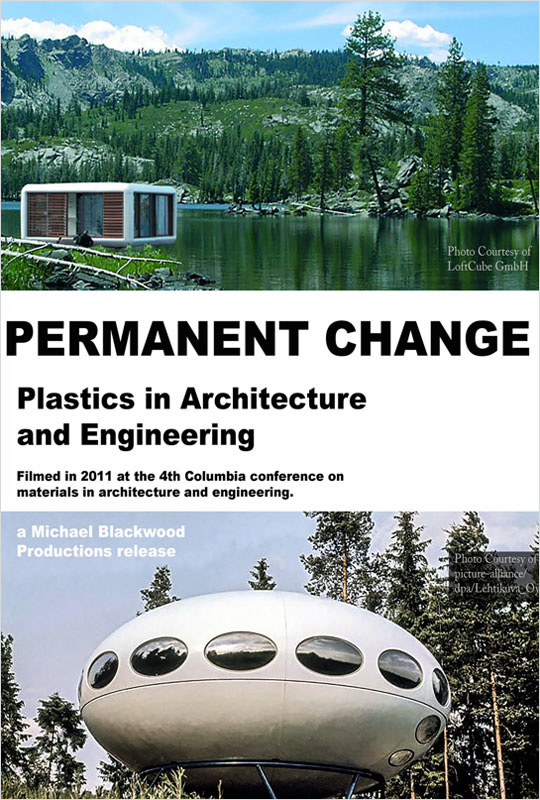Permanent Change: Plastics in Architecture and Engineering
2011 / 59 min. / color
Directed by Michael Blackwood
Filmed in the spring of 2011 at the 4th Columbia conference on materials in architecture and engineering.
The participants in the conference:
Paola Antonelli, Jack Armstrong, Michael Bell, Raimondo Betti, Johan Bettum, Craig Buckley, William F. Carroll, Beatriz Colomina, Hernan Diaz Alsonso, Winka Dubbeldam, Anna Dyson, Billie Faircloth, Mark Goulthorpe, Michael Graves, Laurie Hawkinson, Juan Herreros, Steven Holl, George Jeronimidis, Lydia Kallipoliti, Brian Kane, Sheila Kennedy, Jan Knippers, Craig Konyk, Sanford Kwinter, Sylvia Lavin, Chip Lord, Greg Lynn, Fabian Marcaccio, Michael Meredith, Erik Olsen, Jorge Otero-Pailos, William Pearson, Werner Preusker, Theodore H.M. Prudon, François Roche, Hilary Sample, Rita Schenck, Felicity Scott, Hartmut Oliver Sinkwitz, Werner Sobek, Galia Solomonoff, Heiko Trumpf, Ignaas Verpoest, George Wheeler, Mark Wigley
Plastics have become the most ubiquitous and increasingly permanent materials in construction. The material capabilities of plastics both as a generic material nomenclature and as specific polymers and the processes that underlie them suggest a potential to reshape design and the roles of architects and engineers in construction. While plastics are perhaps the most deeply engineered building materials today, they are still in their nascent stages of understanding in terms of their potential applications and uses. Permanent Change sheds new light on these materials and their implications for the fields of architecture and engineering.
Traced through history, plastics in the overarching sense reveal aspects that are often completely contrary to assumptions. Permanent Change undertakes to reexamine the histories and reassess the futures of polymers, exploring their origins in industry and science as well as their role in domestic and public realms, up through recent advances in composites and the new forms of fabrication assembly these portend. Materials that originally anticipated easily molded, re-formed shapes have become a permanent measure and control point in design. From their means of production to their assembly and to their presence in design, polymers have continually been redeployed and developed in ways that often do not align with either the early scholarship or technical forecasts of their capabilities. Plastics, as both broad material nomenclature and specific polymer, may no longer be capable of sustaining the breadth of cultural ambitions the term has held at various historical points. As a material that is still being engineered and increasingly leads to composite assemblies, how are the multiple histories and mediatic aspects of its developments being remade?
Michael Bell
Professor, GSAPP, Columbia University
Conference Chair
Directed by
Michael Blackwood
Cast
Hernan Diaz Alsonso
Paola Antonelli
Jack Armstrong
Michael Bell
Raimondo Betti
Johan Bettum
Craig Buckley
William F. Carroll
Beatriz Colomina
Winka Dubbeldam
Anna Dyson
Billie Faircloth
Mark Goulthorpe
Michael Graves
Laurie Hawkinson
Juan Herreros
Steven Holl
George Jeronimidis
Lydia Kallipoliti
Brian Kane
Sheila Kennedy
Jan Knippers
Craig Konyk
Sanford Kwinter
Sylvia Lavin
Chip Lord
Greg Lynn
Fabian Marcaccio
Michael Meredith
Erik Olsen
Jorge Otero Pailos
William Pearson
Werner Preusker
Theodore Prudon
François Roche
Hilary Sample
Rita Schenck
Felicity Scott
Hartmut Oliver Sinkwitz
Werner Sobek
Galia Solomonoff
Heiko Trumpf
Ignaas Verpoest
George Wheeler
Mark Wigley
Produced by
Michael Blackwood
Cinematography by
Roger Grange
Mead Hunt
Alan McPheely
Rima Yamazaki
Film Editing by
Joelle Schon
Production Management
Elinor Feist … production manager
Sound Department
J.C. Schlageter … sound recordist
Camera and Electrical Department
Roger Grange … camera operator
Additional Crew
Amy Bostwick … production assistant
Mary Latvis … production assistant
RELATED CATEGORIES
Architecture
Architecture Surveys
SCREENING
Info & Request





